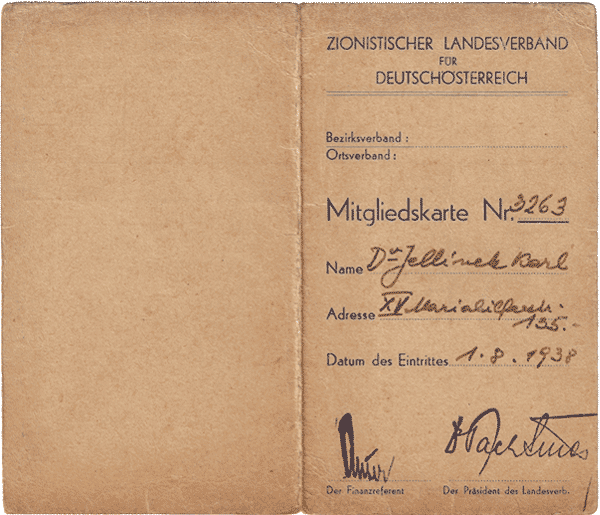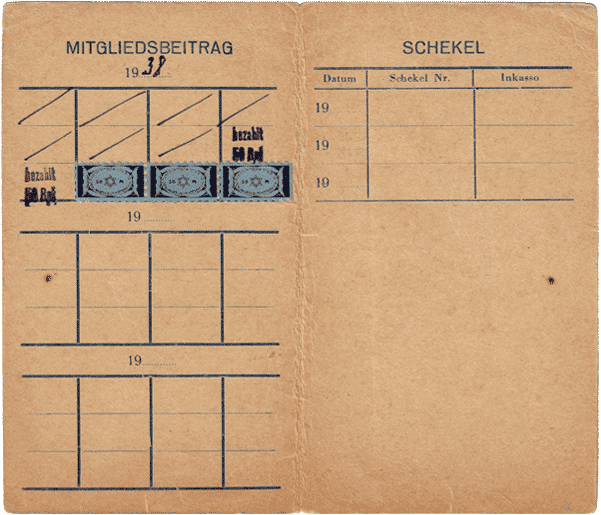Context
In the beginning of May 1938, the Israelitische Kultusgemeinde, Wien (aka IKG ‐ the [chief] Jewish communal organization of Vienna) and the Palästina ‐Amt, Wien (Palestine Office, Vienna) were reopened by Adolf Eichmann. The Palestine Office was a section of the IKG that dealt solely with Jewish emigration to British Mandate Palestine.
The assets, leaders and members of all of the eighty other Viennese Jewish organizations were compelled to be part of and under the supervision of the IKG. But the IKG became only a link in the increasingly constricted chain of Nazi command. The reopened IKG served as a useful intermediary for Eichmann, and was under his and other Nazi authorities’ direction and strict operating orders. The higher‐level Zentralstelle (Central Office for Jewish Emigration) that Eichmann established in August 1938, oversaw the IKG and the Palestine Office.
The March 1938 Anschluss unleashed five to seven weeks of pogrom ‐ like terror and lawlesssness against Jews in Vienna, that resulted in most Jews becoming desperate to escape Austria. From May 1938 until October 1941, there was a confluence of this urgent goal held by the Jewish Community (the IKG) and by the Nazi regime, namely, the mass Jewish emigration from Austria. The Nazis realized that forcing the Jewish community to cooperate and collaborate under their administration led to smoother, faster expulsion of the Jews, thereby rendering Austria “judenrein” — empty of Jews. The Jewish Community’s forced cooperation with the Nazi regime helped the Community get approximately 136,000 people, about 2/3 of Austrian Jewry, out of Austria, and into fifty different countries, on six continents. Karl, his wife, Kreindel and their infant daughter, Michaela, were among those able to flee. The following pages in this same website section, provide key information, as well as documentary evidence of their escape from Austria and into the USA: Karl’s correspondence with the family’s affidavit sponsor and with the US Consulate, as well as Karl and Kreindel’s Nazi‐issued passports.
When Karl, as a long‐time, dedicated Zionist, volunteered at the Palästina‐Amt, Wien, he may have helped with their newspaper, library or any of the other following activities: the processing of Emigration Registration Questionnaires, the coordination of preparations for emigration, including Hebrew language courses, Hachsharah (Hebrew word for agricultural training for farming in Palestine), securing of and fundraising for prospective emigrants’ train and ship tickets, Nazi‐required flight taxes, exit permits, tax office certifications and more.
Tragically however, the Jewish community’s “choiceless choice” of initial cooperation with and obedience to Nazi orders, led to their later coerced cooperation with the Nazis’ deceptive and evil orders to assist with Jewish deportations. For a particularly compelling and poignant account of the process of deterioration of the IKG ‐ Vienna’s role from rescue to involvement in the Jewish community’s destruction, see The Jews of Nazi Vienna, 1938 ‐ 1945: Rescue and Destruction by Ilana F. Offenberger, listed in this website’s Sources’ sub‐section: “. . . Historical Narratives of Particular Relevance . . .” The following books, listed in the Books sub‐section of Sources, provide more detailed information about Jewish emigration to Palestine during the pre‐war period: On the Eve: The Jews of Europe Before the Second World War by Bernard Wasserstein, and Nazi Germany and the Jews, Volume 1: The Years of Persecution, 1933 ‐ 1939 by Saul Friedländer.



